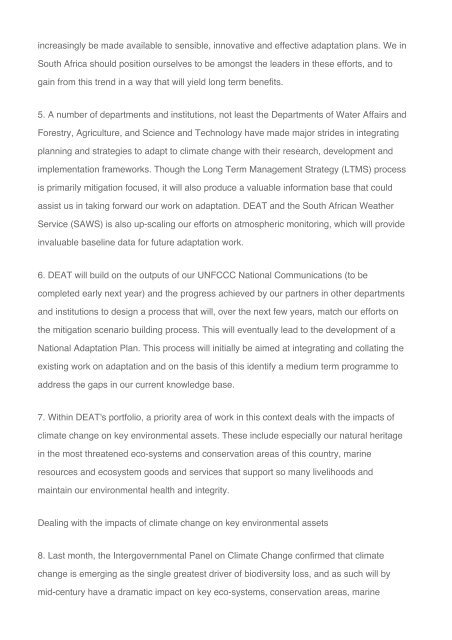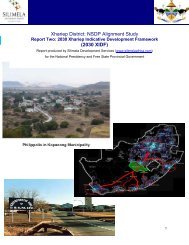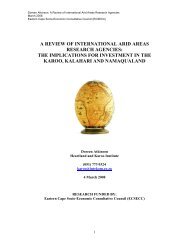Roadmap for National Climate Policy - Arid Areas Programme
Roadmap for National Climate Policy - Arid Areas Programme
Roadmap for National Climate Policy - Arid Areas Programme
You also want an ePaper? Increase the reach of your titles
YUMPU automatically turns print PDFs into web optimized ePapers that Google loves.
increasingly be made available to sensible, innovative and effective adaptation plans. We inSouth Africa should position ourselves to be amongst the leaders in these ef<strong>for</strong>ts, and togain from this trend in a way that will yield long term benefits.5. A number of departments and institutions, not least the Departments of Water Affairs andForestry, Agriculture, and Science and Technology have made major strides in integratingplanning and strategies to adapt to climate change with their research, development andimplementation frameworks. Though the Long Term Management Strategy (LTMS) processis primarily mitigation focused, it will also produce a valuable in<strong>for</strong>mation base that couldassist us in taking <strong>for</strong>ward our work on adaptation. DEAT and the South African WeatherService (SAWS) is also up-scaling our ef<strong>for</strong>ts on atmospheric monitoring, which will provideinvaluable baseline data <strong>for</strong> future adaptation work.6. DEAT will build on the outputs of our UNFCCC <strong>National</strong> Communications (to becompleted early next year) and the progress achieved by our partners in other departmentsand institutions to design a process that will, over the next few years, match our ef<strong>for</strong>ts onthe mitigation scenario building process. This will eventually lead to the development of a<strong>National</strong> Adaptation Plan. This process will initially be aimed at integrating and collating theexisting work on adaptation and on the basis of this identify a medium term programme toaddress the gaps in our current knowledge base.7. Within DEAT's portfolio, a priority area of work in this context deals with the impacts ofclimate change on key environmental assets. These include especially our natural heritagein the most threatened eco-systems and conservation areas of this country, marineresources and ecosystem goods and services that support so many livelihoods andmaintain our environmental health and integrity.Dealing with the impacts of climate change on key environmental assets8. Last month, the Intergovernmental Panel on <strong>Climate</strong> Change confirmed that climatechange is emerging as the single greatest driver of biodiversity loss, and as such will bymid-century have a dramatic impact on key eco-systems, conservation areas, marine






